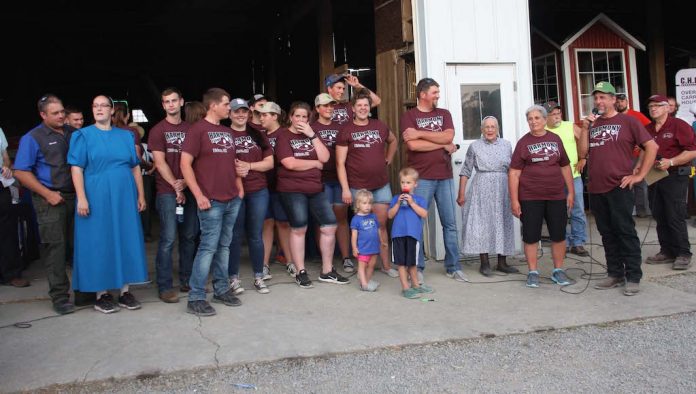
KIDRON, Ohio — Harmony Farms, the aptly named host farm for the 2019 Dairy Twilight Tour July 9, believes that faith, family, farming, and the good of the community are the foundation for their success.
Owned and operated by Phil Neuenschwander and his family, the farm located in Kidron, Ohio, has been in the family since 1862, when Phil’s great-grandfather started farming the land. He passed it on to his son-in-law, Phil’s grandfather, who, in turn, passed it on to Phil’s father. Phil joined his father on the family farm in 1985 and purchased the farm from his father in 2000.
“If it is not good for the community, it is not good for our farm. And nothing is worth sacrificing
your family for your business.” — Phil Neuenschwander, Harmony Farms
Today, the farm is operated by Phil and his family, which includes three sons and six daughters, along with Wendall Hurst, who joined the partnership in 2014 when Phil purchased his brother’s interest in the custom harvesting business and they purchased an additional farm.

Phil Neuenschwander said farming is truly a partnership, not only with family, but with the Creator and the community.
“I think like that every time I plant a seed or see a calf born,” said Neuenschwander. “This is something good to be a part of.”
Neuenschwander also believes the decisions he makes on the farm impact the community as well.
“If it is not good for the community, it is not good for our farm,” he said. “And nothing is worth sacrificing your family for your business.”
Transitions important
“My dad was an evangelist,” added Phil Neuenschwander. “He traveled the world, sharing the gospel and left me to make decisions on the farm.”
Jerrell Neuenschwander said one thing that helped make the transition from one generation to the next was that when his grandpa decided to step back from the farming operation, he was willing to offer advice if needed, but he felt that the next generation needed to be in charge and make the decisions.
And Jerrell saw that trust when he started on the farm at age 16 and his father trusted his judgment with the cows. Jerrell suggested they try crossbreeding the herd with Norwegian Reds, then they added some Jerseys when they bought cattle to help fill a new barn in 2016.
Cow comfort
Harmony Farms currently has a milking herd of about 300 head consisting mostly Jerseys, Jerseys x Norwegian Red crosses, Holsteins, plus replacements. The herd is milked three times a day.
They feed a simple total mixed ration of corn silage, dry hay or soy hulls, high moisture corn and a mineral mix.
The Neuenschwanders looked at several barns before beginning construction on their own barn, and designed their barn to keep the cows clean and comfortable and to have a facility that was easy to work in.
When they built their new freestall barn in 2016, they also installed an innovative heat abatement system that keeps cows cool during the summer. The barn has a row of 28-inch fans above each row of freestalls, with an evaporative cooling system that moves a fine mist over the cows and moves the air continually. They also installed a similar cooling system in the maternity barn.
They bed with sand and use a sand lane manure management system with a 1.5 percent slope, allowing the sand to settle out and recycled to be used again. The manure goes into a lagoon and the water is pumped back in to clean the barn lanes. The freestall barn is flushed several times a day to keep the manure from building up and keep the cows cleaner.
Jerrell Neuenschwander added that they trim the switches on the cows to keep them out of the manure and keep the cows cleaner.
In addition to their dairy operation, they also operate a custom harvesting operation, harvesting about 30,000 tons of products in a year.
Related article:
Extension experts urge dairymen to give DMC, energy audits a look
KIDRON, Ohio — Changes to the Dairy Margin Coverage program have made the program more workable for milk producers.
Dianne Shoemaker, OSU Extension field specialist, said the program’s changes written into the 2018 farm bill make the program more practical, with an increase in the coverage levels as well as a new method of calculating feed costs for dairy cows and replacements.
Shoemaker explained the program to dairy farmers attending the 2019 Dairy Twilight Tour July 9. The tour, sponsored by the Wayne/Ashland Dairy Service Unit, was hosted July 9 by Harmony Farms, owned and operated by the Phil Neuenschwander family in Kidron, Ohio.
She reminded producers this is the last year the program allows producers to sign up during the year the actual coverage takes place. Another option in the program allows producers to sign up for a five-year period with a 25% reduction in the enrollment fees.
She encouraged producers to go to the website dairymarkets.org/mpp/tool for more information.
Energy audits
Chris Zoller, Tuscarawas County OSU Extension educator, reviewed a project underway through OSU Extension, the Ohio State University Department of Electrical and Computer Engineering and Robert Cull, a retired electrical engineer from NASA Glenn Research Center and president of Energy SOS.
A three-year project is looking at the energy demands on livestock farms to find ways to either reduce energy consumption, find more efficient equipment or methods or even out the demand cycle so that farmers aren’t using an excessive amount of energy during peak demand periods.
The tour hosts, the Neuenschwander family, have been part of the study.
Zoller said controlling costs on the farm is critical at all times, but it is even more important when income is challenged due to low commodity prices and weather challenges.
He added that recently the project received a grant from the Ohio Soybean Council to study energy use on crop farms as well.









